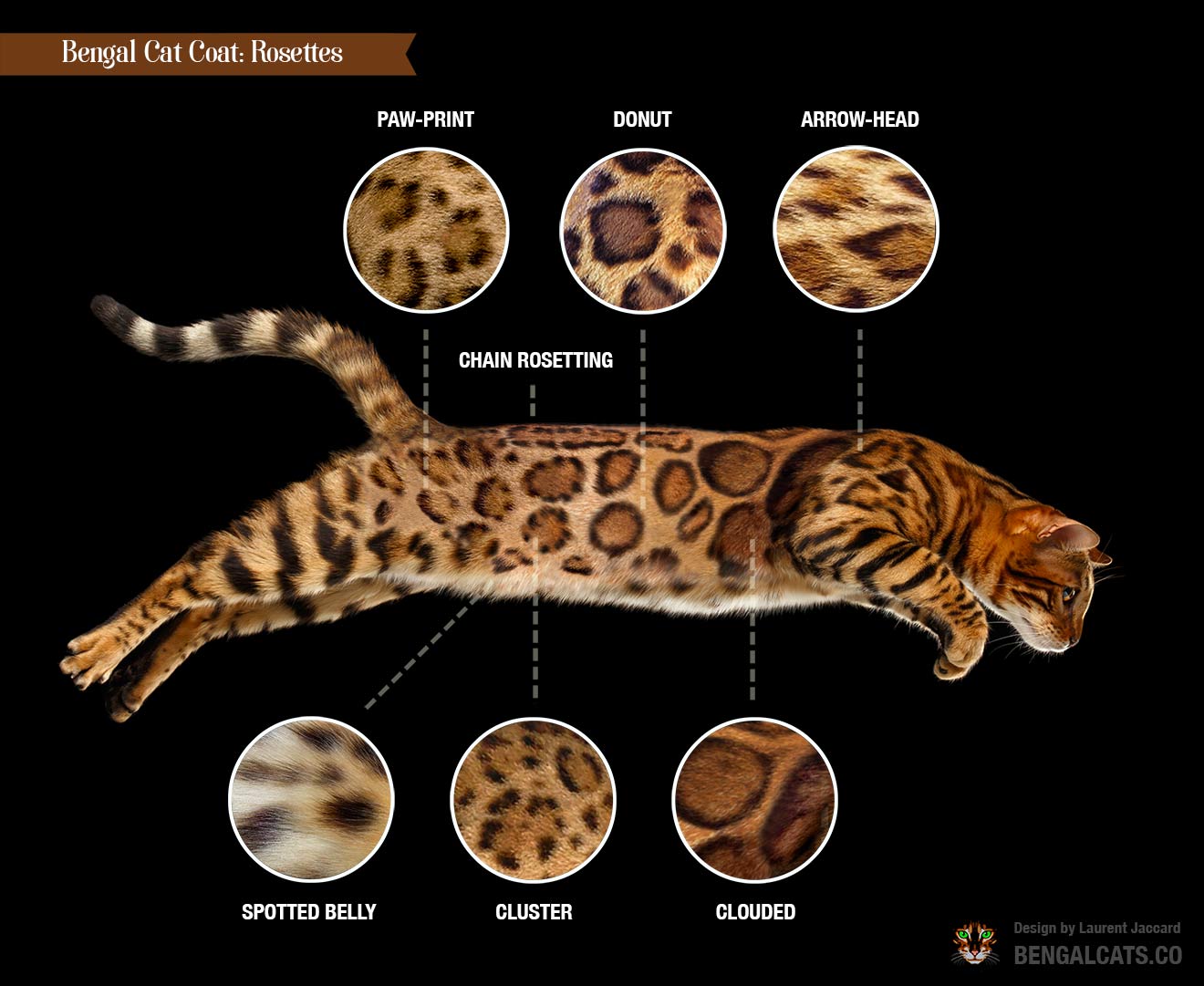The beginnings of rosetted markings in the Bengal Cat
[dropcap]I[/dropcap]n the late summer of 1993 a large group of Bengal kittens awaited judging in King of Prussia Pennsylvania at the largest TICA (The International Cat Association) of the year.
Among the Bengal kittens an array of the breed’s unique qualities were visible to those who saw them.
There was a kitten with an exceptionally sparkling coat, laden with glitter while another kitten’s coat was rich with reddish-orange tones, called rufousing, while still retaining black spots.
Alongside those kittens was another with highly articulated facial features accentuated by striking white markings that created an exotic expression unique to the Bengal Cat.
And then there was a six month old female kitten who when she was placed from the arms of Jean Mill into the judging cage elicited an audible gasp from the audience because of markings no one had ever seen on a domestic cat, rosettes.
The kitten was Millwood Inner Circle, the first rosetted Bengal and the first rosetted domestic cat!
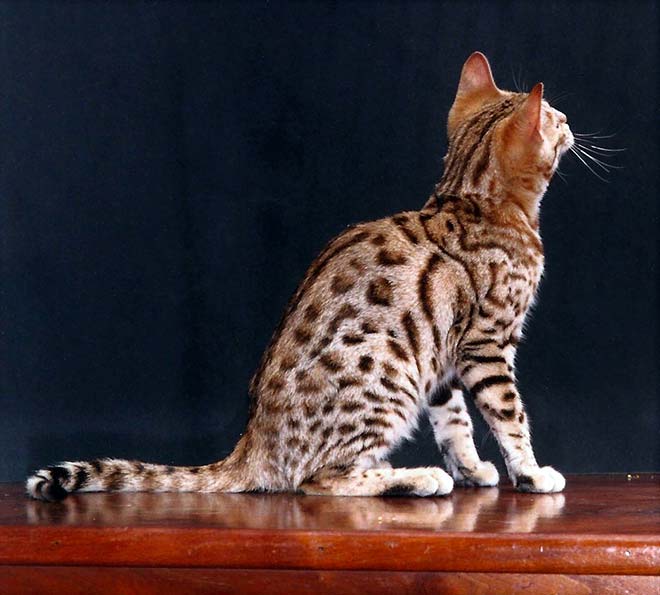
Millwood Inner Circle’s pattern and spotted tail at 6 months – © A.Hutcherson/Bengalcats.co
Rosettes in the Animal Kingdom
Among the world’s assembly of animals the presence of a rosetted variety of spotted pattern is quite rare.
Among land mammals, only those in the order Carnivora does this pattern exist.
Within the carnivores it is only some species within the suborder Feliforma for the cat-like meat eaters such as genets, civets and the cats themselves.
Even among this group rosettes are not common and those species with rosettes have been admired and even coveted since the dawn of civilization.
The pelage of Jaguars and Leopards have embodied the apogee of strength, power, elegance, femininity and masculinity across cultures and continents throughout history.
The Snow Leopard, Clouded Leopard, Ocelot, Margay, Oncilla, Pampas Cat are all routinely rosetted along with the Lion, where contrast fades making markings barely discernible.
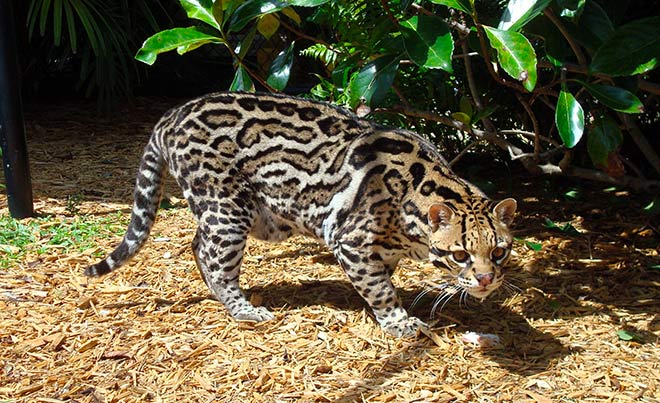
Ocelot at Panther Ridge Conservation Center – © A.Hutcherson/Bengalcats.co
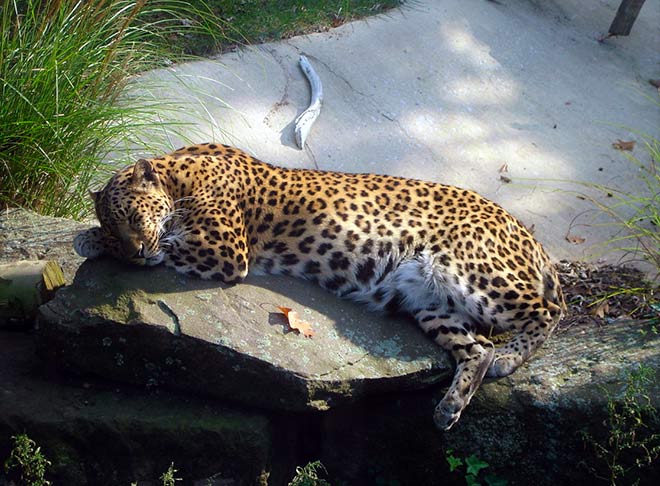
Leopard at Cohanzick Zoo – © A.Hutcherson/Bengalcats.co
Some individual animals and populations among Bobcats, African Golden Cats, Asian Golden Cats, European Lynx, Geoffroy’s Cat and the Asian Leopard Cat are known to be rosetted.
The Asian Leopard Cats Prionailurus bengalensis that contributed to the founding of the Bengal Cat delivered into the realm of the domestic cat and this breed in particular the potential for rosettes, in this author’s opinion.
Early Breeders Efforts
By 1993 in the nearly two years since Bengal Cats were accepted into the championship classes of TICA, affording the breed “domestic cat status” and a place in competition among the oldest and well known breeds, more than 2,000 individual Bengal Cats had been registered.
Breeders such as Jean Mill (Millwood), Gene Johnson (Gogees), Leslie Hall (Junglebook), Tina Woodworth (Echowood), Jane Lee (Hunterdonhall), Judy Frank (Wildwood), Teri Pattison (Windstorm), Karen Austin (Belltown), Libbie Kerr ,(Akerrs), Von Pilcher (Bengaline), Ruth Hodges (Leopardlane), Pat Killmaier (Aluren), Tony Brady (Bradot), Bob Dundon (Nola), Earl Shropshire (Starbengal) and others throughout the United States, Canada and Europe poured significant resources of money, time, effort and passion into the establishment of the breed.
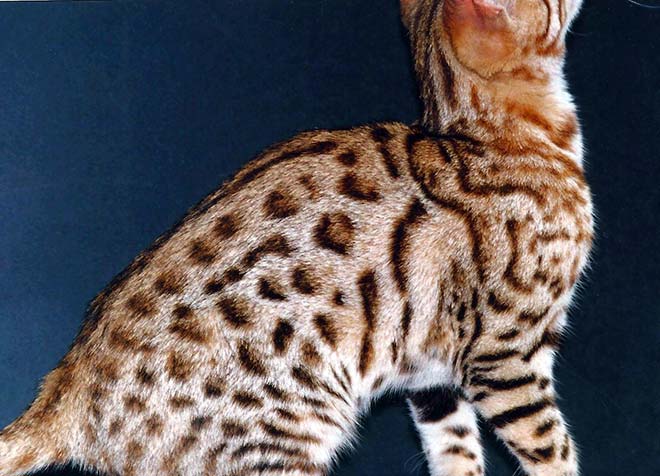
Millwood Inner Circle close up of rosettes – © A.Hutcherson/Bengalcats.co
Nearly all hoped to create a rosette, the distinctive feline marking composed of a background color, spot and a third color inside the spot.
Other Spotted Domestic Cats
The Ocicat and Egyptian Mau were recognized breeds at the time known for contrasted spotted coats.
Neither breed could attempt or anticipate rosettes to develop in their breed.
The Egyptian Mau pattern was developed by selection for the spotted coat from the domestic descendants of the African Wild Cat, Felis sylvestris lybica, principally from a trio of cats owned by Natalie Troubetskoy in the mid 1950’s.
The Egyptian Mau sought a pattern of distinct individual spots in either a random or broken mackerel alignment.
The Ocicat was created by intentional crosses between the Siamese, Abyssinian and American Shorthair starting in the mid 1960’s.
The Ocicat pattern calls for a spotted pattern that mimics the classic tabby circular pattern, referred to as blotched or “bull’s eye”.
Only in the Bengal Cat did even the potential for a rosette exist.
The Bristol Cat is a name used to identify a small group of cats that were never formally recognized as a breed in which a single photograph depicts a rosetted individual.
The origin and make-up of these cats is murky at best.
One of the cats named “Cajun” from that program was photographed by Von Pilcher at the owner’s cattery in Texas and although more than ten years old at the time (1992).
The cat was rosetted and in a conversation, the cattery owner suggested that these Bristol cats were the result of domestic cat and Margay (Leopardus wiedii) hybridization.
Conversations with the individuals associated with an organized community of wild cat owners during that period suggest that wild cat species behind these cats was a very rosetted Asian Leopard Cat that had been sold as a Margay because it would generate a higher sale price.
A single female described as a silver spotted tabby with white feet named “Sugarfoot” was acquired by Solveig Pfluger, PhD, TICA’s Genetics Committee Chair who placed the with Karen Austin (Belltown Bengals).
Contemporary analysis of individuals descending from one of those cats show no genetic markers associated with Margays, Oncillas or any other non-domestic species.
Showing the First Rosetted Bengal
Back TICA Judge Gloria Stephen’s ring in 1993, Millwood Inner Circle and her rosettes were indeed a revelation.
Questions swirled among the gathered exhibitors, breeders and judges.
The excitement as well as the queries traveled throughout the Bengal Cat community about Jean Mill’s cat at the pace of recollections during phone calls, photos being developed and the delivery of mail, as this was prior to email or the internet.
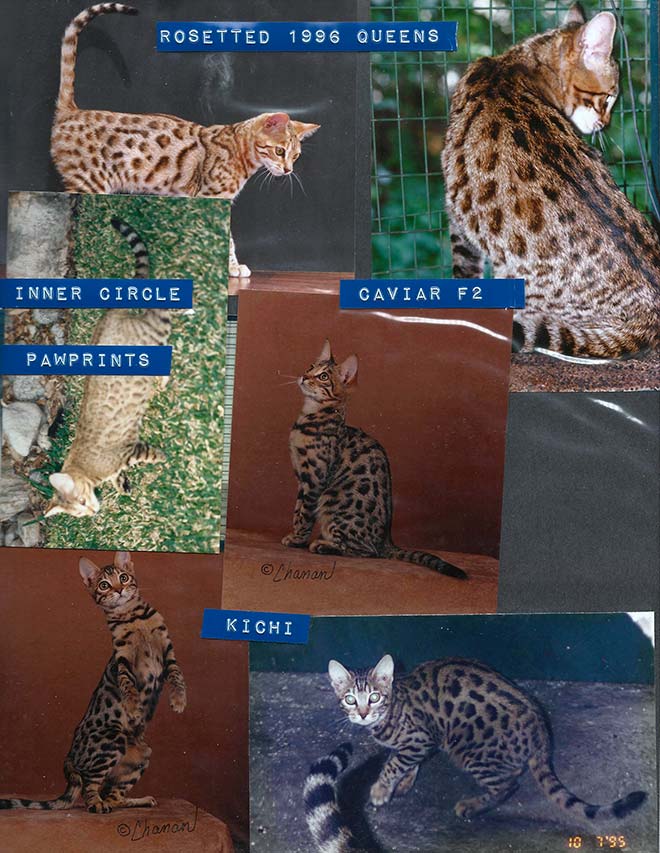
Millwood rosetted queens in 1996 – © A.Hutcherson/Bengalcats.co
The questions were about Millwood Inner Circle as well as for the Bengal breed itself.
The responses in the form of accurate pedigree data, presentation of additional rosetted Bengal Cats and of greatest importance, breeders willingness to share cats with one another that could produce better examples of the trait than even they could imagine.
[tie_list type=”starlist”]
- Was Millwood Inner Circle really an SBT (studbook generation) domestic Bengal Cat?
- How was this cat produced? Was there a formula for producing rosettes?
- Would she be fertile? Would she produce more rosettes?
- Were there other rosetted cats?
- How rosetted could Bengals be? Could rosettes be combined with the other traits of value and importance?
- How prevalent will rosettes be among the Bengal Cat population?
[/tie_list]
All were legitimate questions.
By 1993, Bengal Cat breeders had been able to appreciate rosettes in their cats.
However, all of the rosetted cats were either first or second generation crosses from the Asian Leopard Cat.
Millwood Pawprint and Millwood Wild Rose were both very rosetted second generation, 2G, females who produced precious few offspring.
It seemed the further a breeder went away from the Asian Leopard Cat fewer and fewer rosettes appeared on the offspring.
Asian Leopard Cats can be rosetted, but certainly not all were.
Kabuki of Millwood, Leapole of Newhorizon and Rajah Singh of Junglesong were Asian Leopard Cats were dramatically rosetted Asian Leopard Cats that were now producing among the most rosetted offspring anyone had ever seen.
Breeders lamented at the time the ability to preserve that pattern to the domestic generation.
Millwood Inner Circle was Bengal breeder’s first confirmation that rosettes would be possible in domestic Bengal cats.
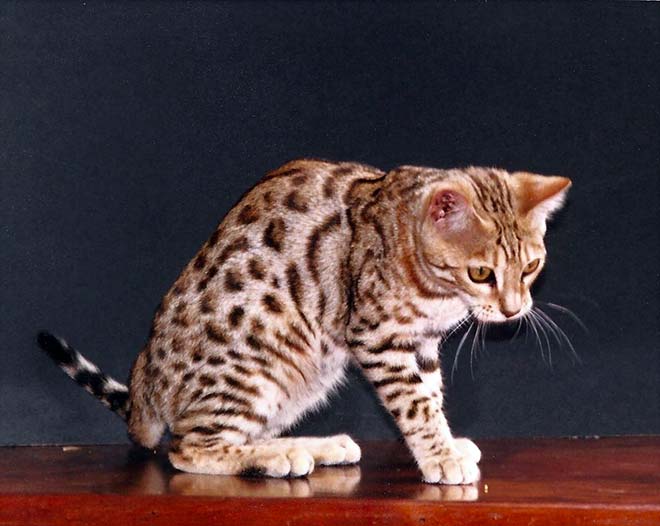
Millwood Inner Circle’s whisker pads (8 months) – © A.Hutcherson/Bengalcats.co
Millwood Inner Circle was the first rosetted Bengal to be widely shown and earn a TICA title.
She ushered in an era of greater rosetting in the Bengal Cat breed that lovers of the breed now enjoy.
Examining the answers to the questions asked of Jean Mill on that Labor Day weekend in 1993 will help us better appreciate and understand this unique trait of the Bengal Cat.
Karen Sausman (Kingsmark) documented and organized the existing patterns of rosettes and color variation within the Bengal breed.
Scientific collaboration with Stanford University, Hudson Alpha Institute, NIH, Texas A&M University, University of Missouri and University of California Davis has also created further insight to the aspects of Bengal pattern and color.
Chris Kaelin, PhD and Greg Barsh, PhD both of Stanford University and the Hudson Alpha Institute continue to this day to lead the efforts to better understand the factors that create a rosette.
Was Millwood Inner Circle a SBT Bengal?
Yes, Millwood Inner Circle was an SBT.
According to her TICA pedigree she is 5 generations from the Centerwall Asian Leopard Cat.
Her sire was the brown spotted tabby Millwood Jokers Wild and her dam was the brown marble tabby Snowbear Cloud Nine of Millwood.
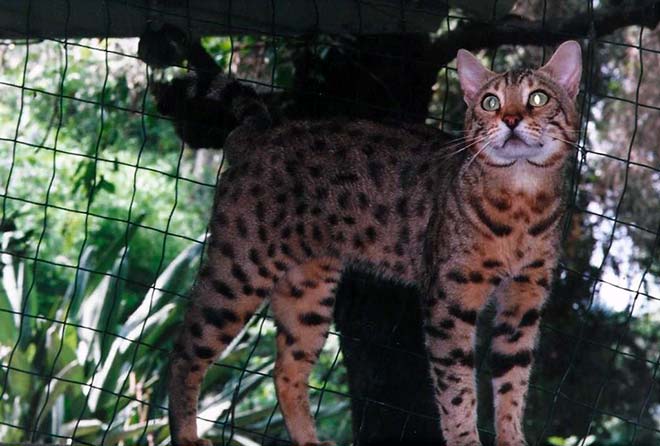
Millwood Jokers Wild – © A.Hutcherson/Bengalcats.co
In reality she was 4 generations removed from the Asian Leopard Cat as her father, Millwood Jokers Wild was a third generation cat (3G) from the Centerwall Asian Leopard Cat via his dam Millwood Penny Ante (2G) and her dam Millwood Pennybank (F1).
Snowbear Cloud Nine of Millwood was four generations removed from the Centerwall Asian Leopard Cat.

Snowbear Cloud Nine of Millwood – © A.Hutcherson/Bengalcats.co
How was Millwood Inner Circle produced? Was there a formula for producing rosettes?
Millwood Inner Circle’s dam, Snowbear Cloud Nine of Millwood was a marble with a highly outlined pattern.
Millwood Inner Circle’s sire, Millwood Jokers Wild was a homozygous spotted Bengal with arrowhead markings.
Millwood Jokers Wild had a spotting pattern was clearly made up of arrowhead spots, like triangles pointing from the cat’s shoulders and front legs toward the hips and back legs.
As word of Millwood Inner Circles rosettes spread, some folks attributed the creation of rosettes to the breeding of a spotted Bengal to a marble.
The marble pattern is the term used to describe the appearance of the blotched tabby, sometimes called classic or bull’s eye pattern, in the Bengal Cat.
Jean Mill produced several of these cats in 1987 and 1988 that were very different from classic tabbies.
Gloria Stephens, TICA’s judging administrator proposed they create a wholly new pattern called marble to recognize how the blotched tabby pattern behaved in the breed because of the Asian Leopard Cat influence.
Marbles became more valuable to breeding programs as that theory circulated.
It was soon clear that not any marble bred to any spotted cat would result in rosetted offspring.
Would she be fertile? Would she produce more rosettes?
Millwood Inner Circle was fertile and produced several litters of rosetted offspring Jean Mill shared with Bengal Cat breeders throughout the world.
Creating more rosettes with Millwood Inner Circle was the challenge and fortunately there were other rosetted Bengal Cats at the time to breed with Millwood Inner Circle.
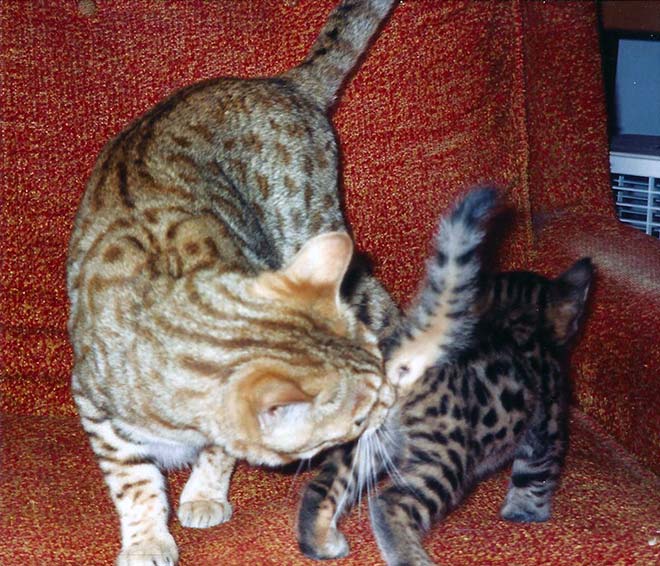
Millwood Inner Circle with Millwood Kichain as kitten 1995 – © A.Hutcherson/Bengalcats.co
Among her rosetted offspring were DGC Millwood Circlet, GRC Millwood KiChain, Inner Light of Nefertelli, Millwood Llandar Braveheart, Millwood Jaguar and CH Millwood Firelit Circle.

Millwood Kichain – © A.Hutcherson/Bengalcats.co
Many of these cats can be found in the pedigrees of the most rosetted cats throughout the world to this day.
CH Millwood Firelit Circle sired with GRC Millwood French Lace the lovely CH Millwood Italian Filagree with his small high contrast rosettes.
CH Millwood Italian Filagree sired over rosetted 40 Bengal Cats placed with breeders throughout the world over the course of his 16 years earning the TICA title OS for OUTSTANDING SIRE, producing ten or more cats earning Grand Championship.
Were there other rosetted Bengal Cats?
Alotaspots Sampson of Heritage was another early rosetted cat bred by Joan Bell of Alotaspots Bengals in 1991, sired by Millwood Lotty with Millwood Kodachrome as his dam.
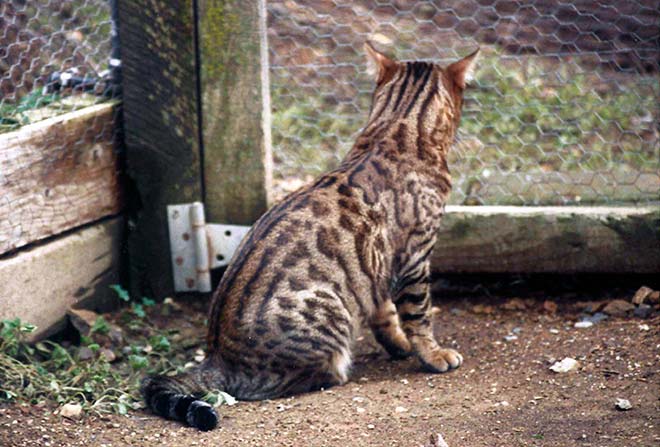
Alotaspots Sampson of Heritage – © A.Hutcherson/Bengalcats.co
Alotaspots Sampston was purchased by June Franklin and Diane Garcia of Heritage Bengals who utilized Sampson’s offerings to create a number of rosetted Bengals throughout the mid 1990s.
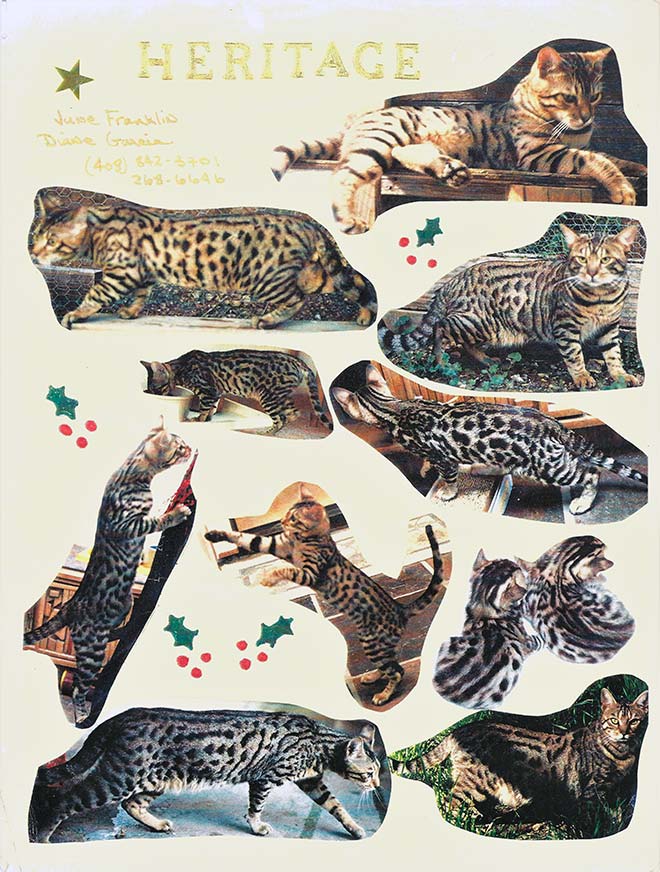
Heritage Bengals in 1997 – © A.Hutcherson/Bengalcats.co
Among his rosetted offspring to contribute to the Bengal Cat gene pool were SGC Heritage Kimo of Almaden, Heritage Tsavo of Bengalpalace, Heritage Muziki of Millwood, Heritage Miradadi of Bengalpalace, GRC Heritage Sungod Ra of Barbs, Heritage Kazuri and Heritage Kahlua of Surprisevalley.
SGC Heritage Kimo and his son CH Heritage Shiloh of Millwood were both bred to Millwood Inner Circle and produced rosetted offspring.
Belltown Bengals in 1992 bred Belltown Flashback that was purchased by Jean Mill.
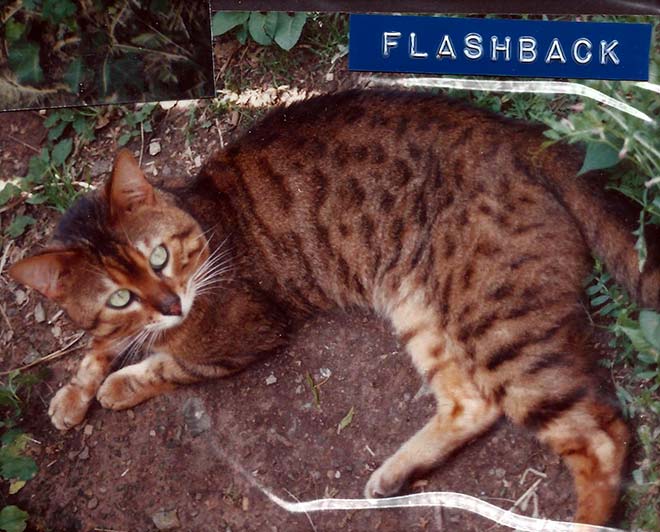
Belltown Flashback of Millwood in 1996 – © A.Hutcherson/Bengalcats.co
Belltown Flashback had half circle rosettes while being both glittered and clear coated.
The cat was sired by RW SGC Huntersmoon Talisman, a fertile fourth generation male from the female Asian Leopard Cat Bonzai with Belltown Apache Tear as dam.
Belltown Flashback would produce over 50 kittens over his life and increase the frequency of rosetting in the Bengal Cat breed.
Because Flashback had a friendly temperament and was a very interested in breeding, Jean Mill would ship him to owners of queens for stud service.
Among his rosetted offspring were DGC Millwood Circlet, Millwood Inner Light of Nefertelli, Millwood Ms Purr of Cheetahsden, Millwood Indian Paintbrush of Leopardlane, Millwood Candlelight, Millwood Mirror Illusion, Millwood Crystal Prism and Wildechos Wildthing.
Wildechos Wildthing called IHOP because of her very large “pancake” rosette on the center of both her left and right sides produced several other rosetted offspring among them the marvelously rosetted GRC Millwood French Lace.
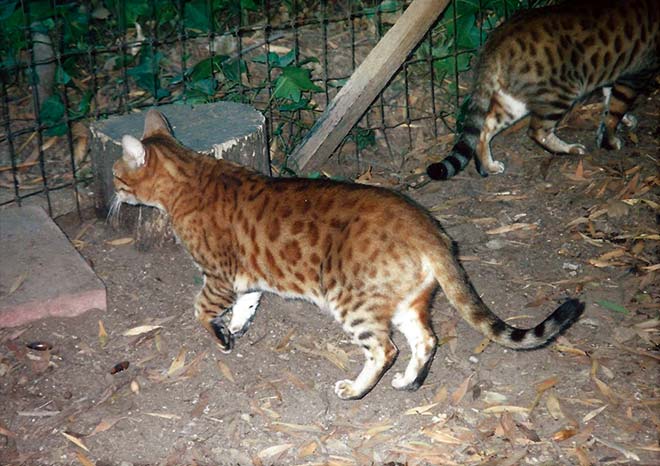
Millwood French Lace in 1998 – © A.Hutcherson/Bengalcats.co
GRC Millwood French Lace was a wonder at the SW Bengal Symposium, a precursor to On Safari in October 1996.
She was gliterred with a white tummy and paw print rosettes the likes had never been seen on a domestic cat in show hall.
GRC French Lace produced over 30 offspring placed with breeders through the course of her life.
Her mark is indelible on the Bengal Cat breed for rosetting.
Jeweliard cattery in Oregon owned by Pat and Judy Latham also began producing rosetted Bengals in 1993 through a breeding with sire Leopardkhan Tanga Tu of Jeweliard and dam Riobengal Jungle Jasmine.
Notably Jewliard Marily of Joykatz and Jewliard Beauty of Joykatz were purchased from the Lathams by Joy Peel of Joykatz in 1994.
Jeweliard Marilyn produced Joykatz Missing Link, Joykatz Acuna Matata of Nairobi and Joykatz Bandido Rosettea.
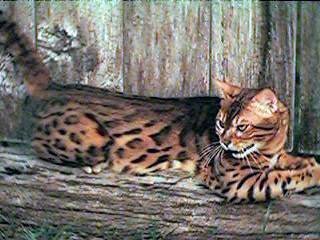
Joykatz Bandido Rosettea is the sire of RW SGC Joykatz Ace Inda Hole who produced many more rosetted offspring for Joykatz that she shared with Bengal breeders throughout the world.
Joykatz Bengals owned by Joy Peel bred these rosetted Bengals to her intricately patterned and outlined marble Bengal, Nola Lamborhini of Joykatz and to foundation generation females.
Joykatz increased the number of highly rosetted Bengals in TICA shows and in breeding programs.
Nola Bengals owned by Bob & Joanne Dundon in Louisiana produced a number of rosetted Bengals in the early 1990s.
Bob Dundon had an interest in the mink and sepia colors but the breeding of Nola Magic Marker of Kingsmark in 1994 and that male’s offspring Nola Voo Doo Magic of Junglebook born in 1995 also produced rosetting.
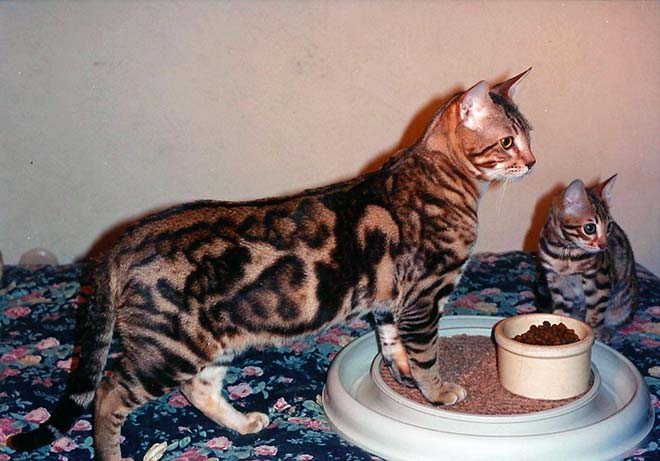
Nola Voo Doo Magic of Junglebook – © A.Hutcherson/Bengalcats.co
Medoz Bengals owned by Donna Syverson produced rosettes in the mid 1990s.
Whispers Trinket of Medoz was born in 1994 sired by Exoticfelines Thunder n Lightning with the dam Exoticfelines Whispers.
When an offspring of Whispers Trinket of Medoz, Medoz Shikara of Jumanji was bred to the rosetted Junglebook Ballistic Legacy, an offspring of Nola Voo Doo Magic of Junglebook dramatic rosettes were created especially Jumanjis Shining Jewel.
Bred by Martha Brady of Jumanji Bengals in 1997, Jumanji Shining Jewel produced offspring that were placed throughout the Bengal Cat community.
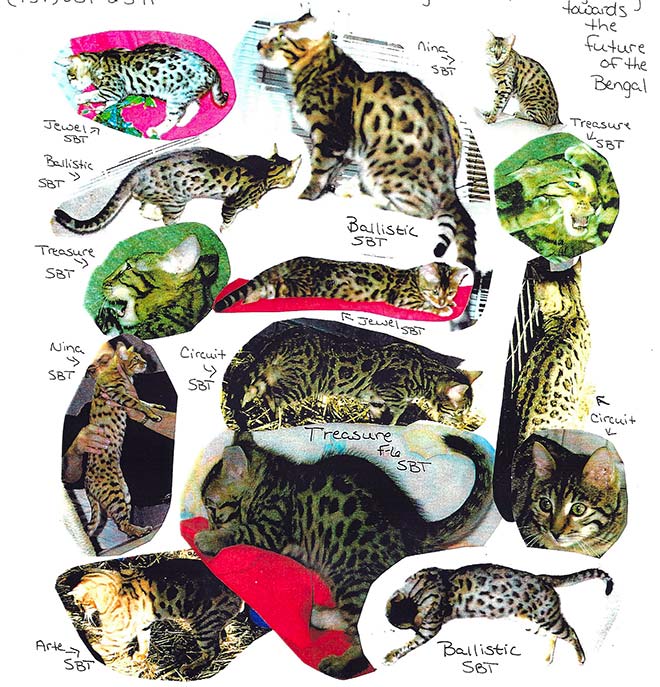
Jumanji Bengals in 1997 – © A.Hutcherson/Bengalcats.co
Millwood Sananawind of Hunterdonhall was a brown marble owned by Jane Tennyson Lee in New Jersey and bred by Jean Mill.
Millwood Sananawind was born in 1991 to sire Millwood Rave Review and dam Millwood Penny Ante.
Note that this female was a repeat breeding of the litter that produced Millwood Jokers Wild who sired Millwood Inner Circle.
She produced several litters but in 1997 when she was bred to Desertrose Diamond Jim, the remarkably rosetted IW SGC Hunterdonhall Tarzan was created.
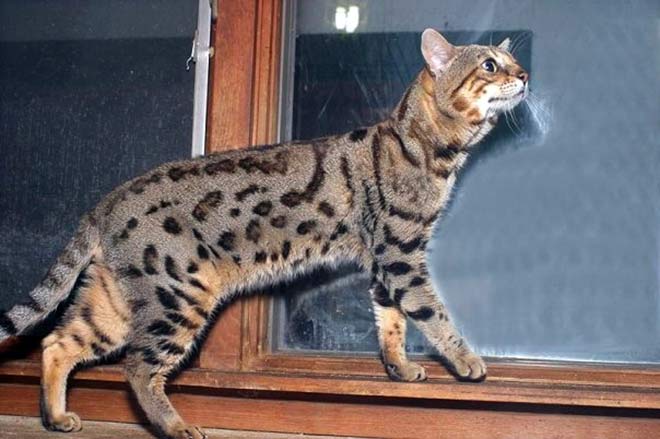
Hunterdonhall Tarzan – © A.Hutcherson/Bengalcats.co
Tarzan was remarkable in extent of his rosetting, as nearly every marking on the cat was rosetted, and the combination of “acreage”, the distance between markings.
SGC Hunterdonhall Tarzan and his mother produced several rosetted cats who continue to influence the Bengal Cat breed.
Jodie Foster of Starbengal was born in 1994 and selected as his pick kitten by Earl Shropshire of Starbengal from breeding his male Starbengal Martin Sheen to the female Cockleslane Leopard Princess.
Jodie Foster of Starbengal had large nearly black spots on a bright glittering gold background and each of those large dark spots “fell out” to create dramatic rosettes.
A combination of the above cats can be found in the pedigree of every rosetted Bengal Cat.
How rosetted could Bengals be? Could rosettes be combined with the other traits of value and importance?
Bengal Cat breeders are still finding out how rosetted a Bengal Cat can be.
The lines on the back of the head, the spotting on the tail and even the spots on the abdomen of Bengals are being rosetted.
Bengal Cat breeders all over the world are proving that rosetting can be combined with every other trait sought in the Bengal Cat such as high contrast patterns, horizontal patterns, exotic expression, small ears and white tummies.
The offspring of the cats and their descendants listed above have been bred to one another, other breeds and Asian Leopard Cats.
Bengal Cat breeders have better understood how rosetting is inherited and may be selected.
Rosettes that were not even imagined are now produced regularly across the globe.
Every manner of arrowhead, pawprint, doughnut and ocelot –like chaining exists, sometimes on the very same cat.
Rosettes are now produced in every color of Bengal, across the full spectrum of the accepted and non-accepted colors.
Among the cats responsible for the existence of rosettes in the Bengal Cat breed some were and had littermates or parents who were longhaired, sex-linked red/orange, lynx point, mink, sepia, classic tabby and other physical traits.
It was the conscious selection that allowed for greater rosetting to exist in Bengals.
Certainly several of the early rosetted cats had lockets, tail faults and minor imperfections that might have caused some to eliminate them from breeding considerations.
All those who love Bengal Cats now are the beneficiaries of the rational choices to forgive a small fault if the potential to create a truly unique wild pattern like rosettes on the domestic cats for the first time in the history of the world.
Rosetted Stripes
It is important to note that while the Bengal Cat focuses on the rosetted spot, Judy Sugden who is Jean Mill’s daughter and founder of the Toyger Cat breed has sought rosetted stripes as exists in some tigers.
Some of the founders of the Toyger breed were part of the Bengal heritage such as Millwood Rumpled Spotskin.
Judy’s Eeyaa Toygers has selected for rosettes to exist as part of the vertical or mackerel tabby pattern of the breed.
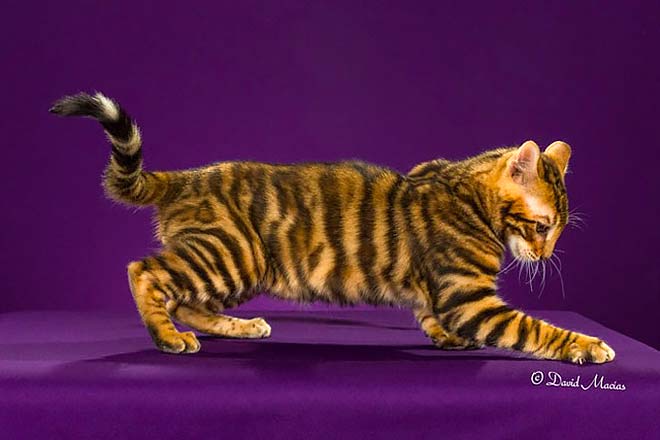
Rosetted Toyger Eeyaa Virtuoshow of Tigervisions – © David Macias
When rosetting exist in Toygers it is called braiding and creates a unique and exceptionally tiger-like appearance.
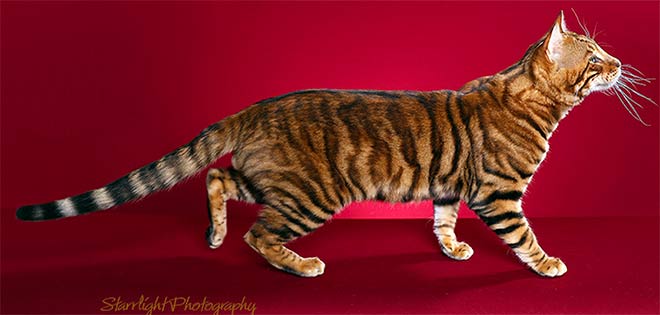
Rosetted Toyger Eeyaa Virtuoshow of Tigervisions – © Starrlight Photography
The painstaking selection that has occurred to create the trait in Toygers demonstrates that rosettes can be added as an aspect to any pattern.
The Rosetted Future
Bengal Cats now have the benefit of nearly thirty years of experience in producing rosettes.
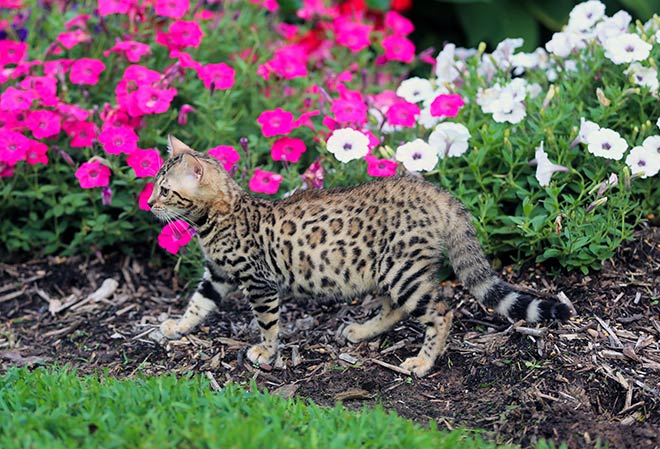
Ticker Tape Parade, rosetted Bengal kitten – © A.Hutcherson/Bengalcats.co
That valuable experience continues to be shared by members of the community with one another.
Science is assisting in unexpected ways today.
Greg Barsh, PhD and Chris Kaelin, PhD of the HudsonAlpha Institute and Stanford University began efforts to identify the genetic changes responsible for making a spotted coat into a rosetted coat in the feline.
Their work for the past decade has yielded a remarkable insight into the genetics of what we are seeing on the Bengal Cat.
Dr. Barsh and Dr. Kaelin’s work is responsible for the discovery of Taqpep short for Transmembrane aminopeptidase Q, which is the genetic variant that creates the blotched or marble pattern.
Their work has also created the most expansive database of Bengal Cat genome.
In 2019, Dr. Kaelin and Dr. Barsh with some assistance from Dr. Kelly McGowan and this author identified the genetic variant responsible for glitter in the Bengal and Egyptian Mau.
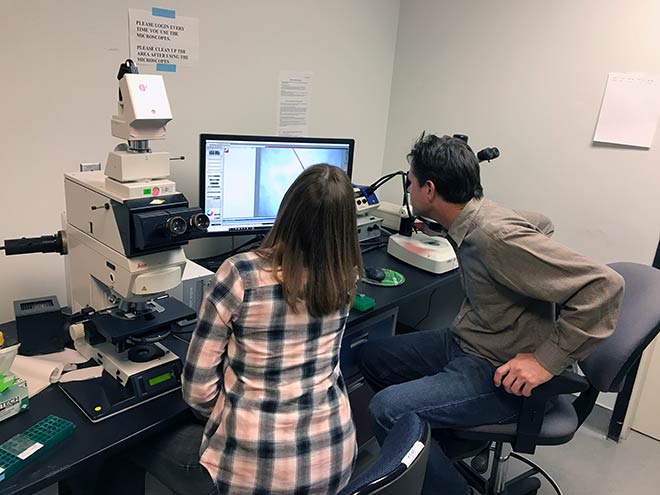
Chris Kaelin, PhD and Kelly McGowan, PhD at Stanford University Medical School Genetics Lab analyzing Bengal Cat samples – © A.Hutcherson/Bengalcats.co
Dr. Kaelin continues his efforts to better understand pattern, pigment and inheritance in the Bengal Cat seeking both samples and collaboration with the Bengal Cat community.
The rosette in the Bengal Cat is still not at full bloom as the extent of rosetting has not been reached.
The examples of rosettes combined with the other much sought after traits in the Bengal Cat continue to exceed even the most optimistic expectations.
The beauty of the rosette on the Bengal Cat is but one aspect of these amiable and remarkable animals we are fortunate to share our lives with.
It reminds one to cherish each marking on our cats, so we might all stop and enjoy the rosette more often.
[products limit=”3″ columns=”3″ orderby=”id” order=”DESC” visibility=”visible”]


